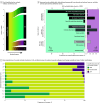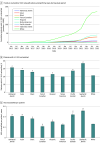Clinical Variant Reclassification in Hereditary Disease Genetic Testing
- PMID: 39504018
- PMCID: PMC11541632
- DOI: 10.1001/jamanetworkopen.2024.44526
Clinical Variant Reclassification in Hereditary Disease Genetic Testing
Abstract
Importance: Because accurate and consistent classification of DNA sequence variants is fundamental to germline genetic testing, understanding patterns of initial variant classification (VC) and subsequent reclassification from large-scale, empirical data can help improve VC methods, promote equity among race, ethnicity, and ancestry (REA) groups, and provide insights to inform clinical practice.
Objectives: To measure the degree to which initial VCs met certainty thresholds set by professional guidelines and quantify the rates of, the factors associated with, and the impact of reclassification among more than 2 million variants.
Design, setting, and participants: This cohort study used clinical multigene panel and exome sequencing data from diagnostic testing for hereditary disorders, carrier screening, or preventive genetic screening from individuals for whom genetic testing was performed between January 1, 2015, and June 30, 2023.
Exposure: DNA variants were classified into 1 of 5 categories: benign, likely benign, variant of uncertain significance (VUS), likely pathogenic, or pathogenic.
Main outcomes and measures: The main outcomes were accuracy of classifications, rates and directions of reclassifications, evidence contributing to reclassifications, and their impact across different clinical areas and REA groups. One-way analysis of variance followed by post hoc pairwise Tukey honest significant difference tests were used to analyze differences among means, and pairwise Pearson χ2 tests with Bonferroni corrections were used to compare categorical variables among groups.
Results: The cohort comprised 3 272 035 individuals (median [range] age, 44 [0-89] years; 2 240 506 female [68.47%] and 1 030 729 male [31.50%]; 216 752 Black [6.62%]; 336 414 Hispanic [10.28%]; 1 804 273 White [55.14%]). Among 2 051 736 variants observed over 8 years in this cohort, 94 453 (4.60%) were reclassified. Some variants were reclassified more than once, resulting in 105 172 total reclassification events. The majority (64 752 events [61.65%]) were changes from VUS to either likely benign, benign, likely pathogenic, or pathogenic categories. An additional 37.66% of reclassifications (39 608 events) were gains in classification certainty to terminal categories (ie, likely benign to benign and likely pathogenic to pathogenic). Only a small fraction (663 events [0.63%]) moved toward less certainty, or very rarely (61 events [0.06%]) were classification reversals. When normalized by the number of individuals tested, VUS reclassification rates were higher among specific underrepresented REA populations (Ashkenazi Jewish, Asian, Black, Hispanic, Pacific Islander, and Sephardic Jewish). Approximately one-half of VUS reclassifications (37 074 of 64 840 events [57.18%]) resulted from improved use of data from computational modeling.
Conclusions and relevance: In this cohort study of individuals undergoing genetic testing, the empirically estimated accuracy of pathogenic, likely pathogenic, benign, and likely benign classifications exceeded the certainty thresholds set by current VC guidelines, suggesting the need to reevaluate definitions of these classifications. The relative contribution of various strategies to resolve VUS, including emerging machine learning-based computational methods, RNA analysis, and cascade family testing, provides useful insights that can be applied toward further improving VC methods, reducing the rate of VUS, and generating more definitive results for patients.
Conflict of interest statement
Figures



Similar articles
-
Diagnostic Outcomes of Concurrent DNA and RNA Sequencing in Individuals Undergoing Hereditary Cancer Testing.JAMA Oncol. 2024 Feb 1;10(2):212-219. doi: 10.1001/jamaoncol.2023.5586. JAMA Oncol. 2024. PMID: 37924330 Free PMC article.
-
Surveillance for Violent Deaths - National Violent Death Reporting System, 50 States, the District of Columbia, and Puerto Rico, 2022.MMWR Surveill Summ. 2025 Jun 12;74(5):1-42. doi: 10.15585/mmwr.ss7405a1. MMWR Surveill Summ. 2025. PMID: 40493548 Free PMC article.
-
Signs and symptoms to determine if a patient presenting in primary care or hospital outpatient settings has COVID-19.Cochrane Database Syst Rev. 2022 May 20;5(5):CD013665. doi: 10.1002/14651858.CD013665.pub3. Cochrane Database Syst Rev. 2022. PMID: 35593186 Free PMC article.
-
Antioxidants for male subfertility.Cochrane Database Syst Rev. 2022 May 4;5(5):CD007411. doi: 10.1002/14651858.CD007411.pub5. Cochrane Database Syst Rev. 2022. PMID: 35506389 Free PMC article.
-
Systemic pharmacological treatments for chronic plaque psoriasis: a network meta-analysis.Cochrane Database Syst Rev. 2021 Apr 19;4(4):CD011535. doi: 10.1002/14651858.CD011535.pub4. Cochrane Database Syst Rev. 2021. Update in: Cochrane Database Syst Rev. 2022 May 23;5:CD011535. doi: 10.1002/14651858.CD011535.pub5. PMID: 33871055 Free PMC article. Updated.
Cited by
-
Experience using conventional compared to ancestry-based population descriptors in clinical genomics laboratories.Am J Hum Genet. 2025 Mar 6;112(3):481-491. doi: 10.1016/j.ajhg.2025.01.008. Epub 2025 Jan 29. Am J Hum Genet. 2025. PMID: 39884281 Free PMC article. Review.
-
Calibrated Functional Data Decrease Clinical Uncertainty for KCNH2-Related Long-QT Syndrome.Circ Genom Precis Med. 2025 Aug;18(4):e005204. doi: 10.1161/CIRCGEN.125.005204. Epub 2025 Jul 18. Circ Genom Precis Med. 2025. PMID: 40677236 Free PMC article. No abstract available.
-
Appropriate time interval to update ambiguous genetic diagnosis in inherited arrhythmogenic syndromes.iScience. 2025 Mar 27;28(5):112300. doi: 10.1016/j.isci.2025.112300. eCollection 2025 May 16. iScience. 2025. PMID: 40276775 Free PMC article.
-
Harnessing genotype and phenotype data for population-scale variant classification using large language models and bayesian inference.Hum Genet. 2025 Jun;144(6):605-614. doi: 10.1007/s00439-025-02743-z. Epub 2025 Apr 23. Hum Genet. 2025. PMID: 40266329 Free PMC article.
-
Calibrated Functional Data Decreases Clinical Uncertainty for KCNH2-related Long QT Syndrome.medRxiv [Preprint]. 2025 May 1:2025.02.05.25321617. doi: 10.1101/2025.02.05.25321617. medRxiv. 2025. Update in: Circ Genom Precis Med. 2025 Aug;18(4):e005204. doi: 10.1161/CIRCGEN.125.005204. PMID: 39974038 Free PMC article. Updated. Preprint.
References
-
- Richards S, Aziz N, Bale S, et al. ; ACMG Laboratory Quality Assurance Committee . Standards and guidelines for the interpretation of sequence variants: a joint consensus recommendation of the American College of Medical Genetics and Genomics and the Association for Molecular Pathology. Genet Med. 2015;17(5):405-424. doi:10.1038/gim.2015.30 - DOI - PMC - PubMed
-
- Clinical Genome Resource . Overview of DRAFT ACMG/AMP v4 sequence variant guidelines. ClinGen. Accessed March 26, 2024. https://clinicalgenome.org/tools/clingen-summer-workshop-series-2023/sep...
Publication types
MeSH terms
LinkOut - more resources
Full Text Sources
Medical
Miscellaneous

